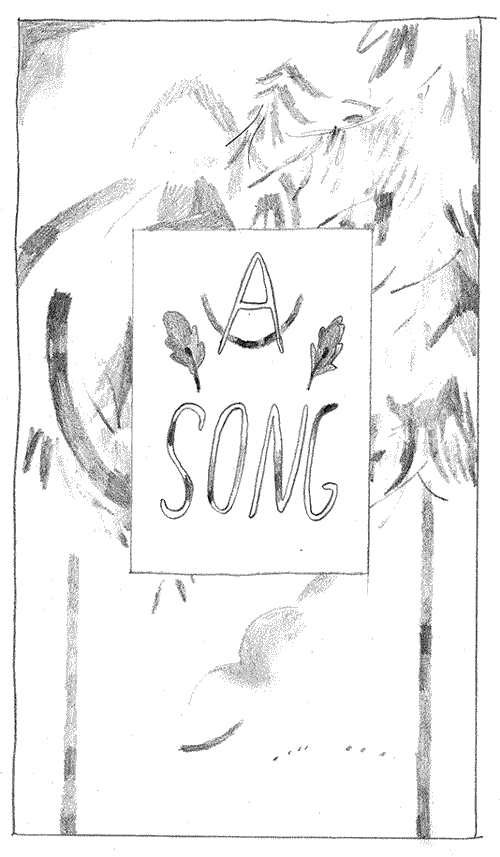In quiet moments, after the roar of a concert or the consistent rapport of an intoxicating conversation, true friendship is realized. It is is not until this connection is solidified, to wait for another day, that one may understand how perfectly another person fits into their life. These moments of quiet contemplation and reminiscing are just as important as the active, energetic parts. This quiet moment is where true narrative brilliance is found, as Aidan Koch makes clear with After Nothing Comes.
The book is comprised of a selection of Koch’s zines spanning six years, from 2008 to 2014. It’s what any zinemaker can only hope their work is: concise, self-knowing, and unlike anything else available. Aidan Koch’s final zine in this collection, Reflections, is a clear example of this, when she completely abandons the panel by panel form that she was confined to in the first zine. Most of Reflections is delicate shading of what I see as the sky, with small text at the bottom as the characters contemplate their relationship. With this zine, Koch asserts her individual style and it’s evident that she’s no longer preoccupied with conforming to traditional comic styles.
It feels essential that this book is comprised of zines, and understanding their original physical form only amplifies the subtextual messages of the book. The first couple of the zines were string or sewn bound, appropriately delicate given Koch’s thoughtful style. Throughout the book, it is evident that she uses zines as a site for experimentation, as most zinemakers do — they don’t seem overly perfected. It seems that Koch is simply unusually graceful at experimenting, finding a way to make her comics individual yet accessible and, perhaps most importantly, to make them connective and pleasurable. In __, where After Nothing Comes finds its cover drawing, her drawing is experimental — large boxes of pencil shading, surrounded by drawings of specs of confetti — yet this draws me in closer to the narrative which is about forgetting loneliness.
 Preoccupied with visual emptiness, Koch’s drawings can mean something different to each viewer as one mentally fills in the story and injects their perspective. Upon reading the short story “A Song” from her 2009 zine, Vastness No. 1, which depicts two girls lazing around the forest, I couldn’t help but think of my own girlhood. One of the girls proclaims “We’ll be a book of poetry!” and the next ascribes the role of Walt Whitman to herself and Ernest Hemingway to the other. I can’t think of a more delicate way of transmitting a childhood yearning for adulthood and grasp for sophistication than by mentally playing dress up as two poets. Upon coming to this decision, the girls sit in what is presented as silence, caught up in a world that can only be so insular when you are at that age. I think of Olivia Bee’s photography, particularly those that depict young women deep in thought even when surrounded by action, and how Koch and Bee similarly depict this incomplete self understanding that’s unique to adolescents. The silence is well suited to two girls trying to make sense of who they are and where they fit into the world.
Preoccupied with visual emptiness, Koch’s drawings can mean something different to each viewer as one mentally fills in the story and injects their perspective. Upon reading the short story “A Song” from her 2009 zine, Vastness No. 1, which depicts two girls lazing around the forest, I couldn’t help but think of my own girlhood. One of the girls proclaims “We’ll be a book of poetry!” and the next ascribes the role of Walt Whitman to herself and Ernest Hemingway to the other. I can’t think of a more delicate way of transmitting a childhood yearning for adulthood and grasp for sophistication than by mentally playing dress up as two poets. Upon coming to this decision, the girls sit in what is presented as silence, caught up in a world that can only be so insular when you are at that age. I think of Olivia Bee’s photography, particularly those that depict young women deep in thought even when surrounded by action, and how Koch and Bee similarly depict this incomplete self understanding that’s unique to adolescents. The silence is well suited to two girls trying to make sense of who they are and where they fit into the world. 
It is not only narrative silence that Koch has a gift for, but also blank space. In "The Dancer At Midnight", panel after panel of the dancer in smudged ink. Instead of seeming lazy, it’s quite clearly the opposite. Koch makes it clear that she’s just as capable of destroying, or leaving her page’s devoid of, her laborious drawings as she is of ensuring that they are finely detailed. As the book progresses and the zines become more recent, it’s clear that Koch is becoming more comfortable with leaving the pages emptier and emptier. After Nothing Comes is the perfect title for this collection because it is where the stories happen, when one is left to contemplate and make sense of the blank space.







